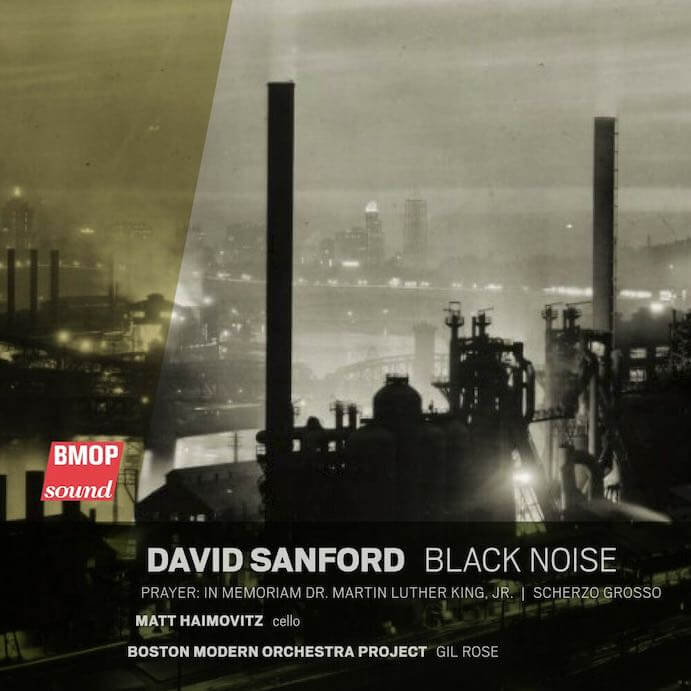In relation to music, noise occupies a particularly complex position in the history of African American musical cultures. Historically, white listeners musically and culturally disenfranchised enslaved African Americans by characterizing their drumming and spirituals as noise out of fear of violent revolt. The descendants of these same listening practices have labelled certain jazz idioms, rap, hip-hop, and their stylistic progeny as forbidden and dangerous, but these characterizations neglect the validity and reality of African American experiences expressed in these and other genres. For instance, noise re-appropriated as richly-textured artistic activity has created space for Black empowerment and individual expression, seen in the Association for the Advancement of Creative Musicians collective improvisations and Beyoncé’s 2018 Homecoming performance at Coachella.
Black Noise (2019, BMOP/Sound) features three orchestral works by composer David Sanford, carefully interpreted by the Boston Modern Orchestra Project (BMOP) under the direction of Gil Rose, in which Sanford implicitly reflects on the complexity of this sonic history in a contemporary classical idiom. Exploring a variety of subjects and forms through his own evocative and narrative-driven compositional voice, Sanford makes progress towards his goal to “promote and normalize the contribution of Blacks in classical music.”
David Sanford
At first glance, the album suggest strong roots to Boston, New England musical institutions, and academia more broadly. While Sanford acknowledge these influences, the musical heart of Black Noise resides squarely in Pittsburgh where he was born and raised and to which Rose and Robert Kirzinger, who provides the albums remarkably informative notes, all have strong ties. In the early 20th century, the city’s Hill District hosted numerous churches, schools and other institutions that supported African American life and musical culture. In the liner notes, Sanford vaguely recollects his father taking him to this very place in the aftermath of the riots that ensued after Martin Luther King’s assassination. Today, Sanford maintains regular musical connection to Pittsburgh through the Pittsburgh Collective, a fusion ensemble comprised of musicians working in jazz, classical, and new music.
In the album’s opening and eponymous composition, Black Noise (2017), Sanford reconciles his geographic and musical influences to present an abstract interpretation of noise as sound, gesture, and timbre. The work showcases his compositional signature: the ability to masterfully shift between, juxtapose, and synthesize styles in an authentic and personal manner. Black Noise develops a series of carefully constructed, texturally diverse episodes–demarcated through moments of brief silence and resounding arrival–to construct a richly allusive narrative. While individual voices move to the forefront, Sanford’s careful orchestration and the individual performances of the BMOP musicians give musical agency to soundscapes of cacophonous aggregations of visceral air and pitch gestures, harmonious collections of crystalline timbres, and conglomerations of motoric string motives and saxophone multiphonics.
Through Prayer: In Memoriam Dr. Martin Luther King Jr. (1992), Sanford draws upon his own personal and musical experiences growing up in Pittsburgh to synthesize a genre bending narrative depicting the plurality of African American voices resonating within city’s history. This narrative is anchored through a series of intensely expressive solo interludes from Sarah Brady (flute) and Eric Berlin (trumpet), suggesting both soulful calls for peace and desperate pleas for freedom. The musical character suggested in each interlude joins larger textures in which stylistic voices are powerfully transformed through unification and individuated via noisy juxtaposition. A particularly evocative instance of this occurs when Brady’s flute solo galvanizes a progression through big band section playing and serialist harmonies, culminating in a driving funk/rock beat replete with a screaming horn section. Again, Gil Rose and BMOP perform with incredible precision and unbridled intensity in equal measure.
Scherzo Grosso (2006) for cello and orchestra is the product of Sanford’s ongoing collaborative relationships with the Pittsburgh Collective and virtuoso cellist Matt Haimovitz. In the context of the whole album, Scherzo Grosso sounds as a post-modern synthesis and extension of the compositional techniques and dizzying number of styles heard in the previous works. Amidst BMOP at the height of Sanford’s stylistic and sonorous noise, the most striking moments are the silences in Haimovitz’s captivating interpretation of the expansive cadenza. What one is left to contemplate in these moments is if the work could serve as a model for equitable inter-cultural exchange, listening, and understanding.
Matt Haimovitz–Photo by Christopher Lane
Setting aside the album and turning their attention to Pittsburgh, the listener hears voices protesting the death of Antwon Rose II at the hands of the police and the reconstruction and gentrification of the city’s historically black neighborhoods. Black Noise provides a powerful musical model for how to generously listen for the humanity and plurality of these voices as well as the history of the spaces and institutions within which they resonate. To do so requires acknowledging the biases of our own listening practices, both musically and in social and political discourse. By adopting these listening strategies on a local level, we may also succeed in normalizing the recent landmark achievements by African American composers and ensure that their underrepresentation is no longer an issue for professional organizations, educational institutions, and youth.

